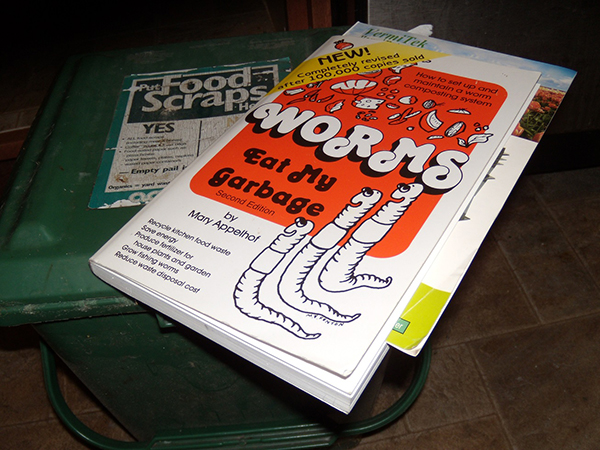by Margie Siegal
A while back I lived in a condo in Oakland (long story) and wanted to be able to recycle my vegetable peels and such. I somehow learned that there was something called a worm bin.
 Of course, basically being a city girl, I knew absolutely nothing about worm bins, except that a worm bin would take care of my recycling problem. So, being a city girl, I looked for a book on worm bins. I found Worms Eat My Garbage.
Of course, basically being a city girl, I knew absolutely nothing about worm bins, except that a worm bin would take care of my recycling problem. So, being a city girl, I looked for a book on worm bins. I found Worms Eat My Garbage.
Worms Eat My Garbage is one of those rare self-publishing success stories. Mary Appelhof, of Kalamazoo, Michigan, leveraged a background in biology and teaching into a best selling book and a successful business selling worm composting supplies. The book is now in its third edition and still selling like hotcakes. Now that she is no longer with us, a friend of Mary’s has revised the book to take advantage of new products and new knowledge. The wormy basics are still the same, so feel free to buy a used copy of the second edition and save some money.
Ms. Appelhof must have been a good teacher. She skillfully weaves together practical information, basic worm biology and humor. She also understands that the reaction of many people to worms is “YUCK,” and deals with that aspect of vermiculture (keeping your worms healthy) as well.
A worm bin is basically a stack of plastic trays, with a simple ventilation system and a cover over the top. The worms to use are redworms, Eisenia fetida in scientific terminology. You can either beg some worms from a friend or neighbor with a worm bin, buy worms from one of several local sources (Google “redworms” or “composting worms”) or order worms on line. A bin to house your worms is not expensive and is available from several different sources, or if you are a handy person, you can build your own. There are plans for do it yourself worm palaces in Worms Eat My Garbage. However, given the price of lumber, there no real cost advantage to building your own unless you are using up scraps from another project.
After carefully reading this book, I bought a worm bin, filled it with torn up newspaper and the kitchen scraps I had been saving, wetted everything down and added the worms I had bought. The bin was amazingly low maintenance. All I did was take off the cover and the top layer of newspaper, dump in scraps, and replace the top newspaper layer and cover. I did this about once a week, when my kitchen compost container was half full. Every once in a while, I would poke around and look for worms. I would see worms scurry away from the light, conclude that they were doing just fine and replace the cover.
The worm bin was out on the deck because I had been concerned about odor when I put my bin together, but the bin never smelled. In fact, unless I pointed it out to visitors, no one realized that the dark green plastic box on the deck was a worm bin.
The one item that I had to keep an eye on was the level of worm tea. Worms like to be moist but not soggy wet. They produce a lot of moisture, which drains into the lower unit. My bin had a little spigot to drain the tea. It’s supposed to be good fertilizer for ornamentals, but due to bacteria count, not appropriate for food plants.
I became very fond of Worms Eat My Garbage. Anytime I had a question, I looked it up in the very detailed index. The book is clear, comprehensive and has informative (and often funny) illustrations.
Eventually, I had several pounds of worm castings. I hauled them to a friend’s garden. The worms stayed in the bin and continued eating my kitchen scraps and making castings. I stopped seeing my kitchen scraps as waste or garbage, and started seeing them as the first step in making excellent fertilizer. Worm castings sell at a premium in garden supply stores. Some people think that fertilizing with worm castings can help plants shake off fungal diseases. Ms. Appelhof’s book provides detailed information on the benefits plants can receive from worm castings.
When I moved to Alameda, I became the owner of two large outdoor compost bins. I gave my worm bin to an Oakland school teacher who planned to install it in her classroom and use it to enhance science lessons.
A worm bin is an excellent way for people who live in apartments or condominiums to convert the unavoidable waste from food preparation (and the avoidable waste from forgetting food until it is past its prime) into a valuable product. Not every part of the vegetables you buy can be used as food. Worms Eat My Garbage is an excellent primer and resource for putting those worms to work.
